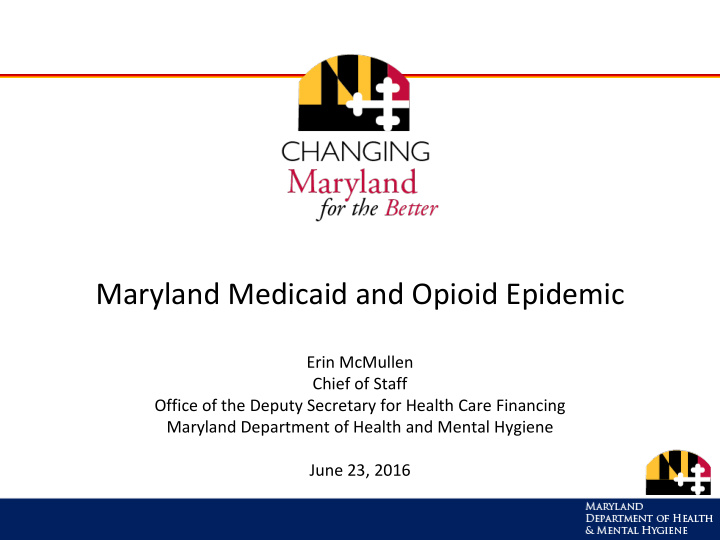



Maryland Medicaid and Opioid Epidemic Erin McMullen Chief of Staff Office of the Deputy Secretary for Health Care Financing Maryland Department of Health and Mental Hygiene June 23, 2016
National Opioid Addiction and Overdose Epidemic
Maryland Opioid Addiction and Overdose Epidemic
Drivers of the Opioid Epidemic • Prescription Drug Sales • Changing Economics of Heroin • Rise of Fentanyl States with More Opioid Pain Reliever Sales Tend to Have More Drug Overdose Deaths
Medicaid and Opioid Epidemic • 816 (65%) of opioid overdose deaths in 2015 were enrolled in Medicaid at any point after January 1, 2011. Of that amount, 691 were enrolled in Medicaid at some point during CY 2015. – 67.5% of participants were male – The majority of participants were white (61.9%) or African American (29.2%). – Most participants lived in suburban Baltimore (35%), Baltimore City (33.1%), and Western Maryland (10.5%)
Demographic Characteristics of Medicaid Participants with a Death Caused by Opioid Overdose
Demographic Characteristics of Medicaid Participants with a Death Caused by Opioid Overdose
Medicaid and Opioid Epidemic Prescription Opioid-Related Emergency Total Prescription Opioid-Related Emergency Department Visits by Expected Payer: Maryland, Department Visits Charges: Maryland, 2008- 2008-2014 2014 $1.6 $1.5 Medicaid $1.4 $1.3 $1.2 $1.2 Dollars (in millions) $0.9 $1.0 $0.7 $0.8 $0.6 Commercial $0.6 Medicare $0.4 $0.4 Self Pay/No Charge $0.2 $0.0 2008 2009 2010 2011 2012 2013 2014 Year
Medicaid and Opioid Epidemic Heroin-Related Emergency Department Visits by Total Heroin-Related Emergency Department Expected Payer: Maryland, 2008-2014 Visits Charges: Maryland, 2008-2014 $1.8 Medicaid [VALUE] $1.6 $1.4 Dollars (in millions) $1.2 $1.00 $1.0 Self Pay/No $0.8 $0.72 Charge $0.6 Commercial $0.39 $0.34 $0.4 $0.29 $0.23 $0.2 Medicare $0.0 2008 2009 2010 2011 2012 2013 2014 Year
Response to Opioid Epidemic • Given the complexities of the epidemic and its far reaching nature, addressing the opioid epidemic requires comprehensive action by multiple stakeholders, including: – Preventing medical and non-medical opioid misuse, abuse, and addiction from developing; – Identifying and treating opioid dependence early in the course of the disease; – Preventing overdose deaths, medical complications, psychosocial deterioration, transition to injection drug use, and injection-related infectious diseases through expansion of treatment and harm- reduction approaches, such as access to naloxone; and – Using data to monitor and evaluate activities.
Key DHMH Activities • Increased Surveillance • Treatment and Recovery • Primary Prevention • Community Interventions/Harm − OMPP Reduction − Communications – Naloxone Expansion − Clinical Education – Crisis Hotline • Early Identification – LOFRTs − PDMP – OSOP − Medicaid Corrective Managed Care − SBIRT 11
Why Target the Managed Care Organizations (MCOs)? • Over 20% of Marylanders enrolled in Medicaid • Statewide reach • 6 of 8 MCOs are integrated provider and payer networks
Medicaid Overdose Activities Accomplishments: Naloxone Prescription Trends In Maryland Medicaid • MCO Corrective Managed 1400 1281 1200 Care Program 1006 Total Number 1044 1000 • Medication Assisted 907 800 600 Treatment (MAT) Access 400 • Screening, Brief 200 19 0 17 Intervention, and March - September October 2014- December 2015 - 2014 December 2015 Present Treatment (SBIRT) Total Naloxone Prescriptions Dispensed coverage Total Number of Unique People with a Naloxone Prescription • Naloxone Expansion 13
Medicaid Overdose Activities Future Activities/Goals: • Drug Utilization Review Activities: Early stage development of minimum standards for Drug Utilization Review activities • Substance Use Disorder (SUD) waiver: Aims to allow Medicaid to pay for SUD treatment services in an Institute for Mental Disease; Medicaid is working with the Centers for Medicare & Medicaid Services and technical assistance providers with goal of amendment approved in July 2017. • Rebundling: The Department has solicited stakeholder input to rebundle the weekly rate for methadone services to improve access to counseling services. A revised draft proposal was circulated at the end of April. • Pharmacy and Therapeutics (P&T) Committee: Use P&T Committee as a forum for overdose education and drug access/contraction 14
Recommend
More recommend